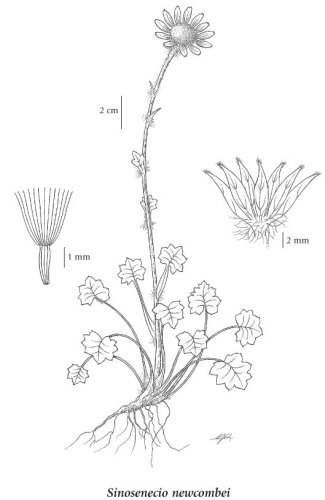Tephroseris newcombei
Newcombe's butterweed
Asteraceae (Aster family)
Introduction to Vascular Plants
Newcombe's butterweed
Asteraceae (Aster family)
Introduction to Vascular Plants
Species Information
General:
Perennial herb from a fibrous-rooted short, horizontal to ascending rhizome; stems erect, solitary, simple, glabrous or sparsely to moderately long-hairy with whitish multicellular hairs, 10-30 cm tall.
Leaves:
Basal leaves egg-shaped to rounded or kidney-shaped, long-stalked, 1.5-10 cm long including the stalk, 1-3 cm wide, glabrous to sparsely long-hairy or stiff-hairy, sometimes from short separate shoots; lower stem leaves similar, glabrous to conspicuously white woolly-hairy in the leaf axils, becoming reduced and few-lobed or entire upwards.
Flowers:
Heads with ray and disk flowers, solitary, with stalks glabrous or sparsely to moderately woolly-hairy with whitish multicellular hairs; involucres 5-12 mm tall; involucral bracts oblanceolate, green, margins translucent and jagged to fringed with small hairs above, hairy at the tips; bracteoles few, inconspicuous or lacking; ray flowers yellow, mostly 7-16 mm long; disk flowers yellow.
Fruits:
Achenes oblong, ribbed, glabrous; pappus of white hairlike bristles.
Notes:
This species has recently been moved to Sinosenecio from Senecio. The microcharacters separating our species of Sinosenecio from other Senecio in our flora are the uniform entire stigmatic areas and the cylindric stamen filaments of the "tussalaginoid lineage" and also the thickenings in the transverse walls of the endothecial cells, i.e., the thickenings are "polarized" (Janovec & Barkley 1996). In addition, the chromosome number of this species is n = 24, a number not known among Senecio. This use of microcharacters runs counter to our overall taxonomic concept of a practical flora, but since all other North American treatments will follow this treatment we will as well.
Illustration

If more than one illustration is available for a species (e.g., separate illustrations were provided for two subspecies) then links to the separate images will be provided below. Note that individual subspecies or varietal illustrations are not always available.
Illustration Source: The Illustrated Flora of British Columbia
Ecology
Ecological Framework for Tephroseris newcombei
The table below shows the species-specific information calculated from
original data (BEC database) provided by the BC Ministry of Forests and Range.
(Updated August, 2013)
The table below shows the species-specific information calculated from
original data (BEC database) provided by the BC Ministry of Forests and Range.
(Updated August, 2013)
| Site Information |
Value / Class |
||
|
Avg |
Min |
Max |
|
| Elevation
(metres) |
631 | 50 | 990 |
| Slope
Gradient (%) |
44 | 0 | 120 |
|
Aspect (degrees) |
106 | 0 | 360 |
| Soil
Moisture Regime (SMR) [0 - very xeric; 4 - mesic; 8 - hydric] |
3 | 0 | 7 |
| Modal
Nutrient Regime
Class |
B | ||
| #
of field plots species was recorded in: |
51 | ||
| Modal
BEC Zone Class |
MH | ||
|
All BEC Zones (# of stations/zone) species was recorded in |
AT(4), CMA(7), CWH(9), MH(31) | ||
|
Source:
Klinkenberg 2013
|
|||
Habitat and Range
Moist bogs, meadows, rocky slopes and forests in the lowland to alpine zones; endemic and common on the Queen Charlotte Islands.Status Information
Synonyms
Synonyms and Alternate Names:
Sinosenecio newcombei (Greene) J.P. Janovec & T.M. Barkley